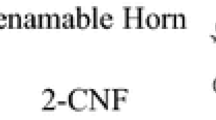Abstract
This paper investigates the complexity of a general inference problem: given a propositional formula in conjunctive normal form, find all prime implications of the formula. Here, a prime implication means a minimal clause whose validity is implied by the validity of the formula. We show that, under some reasonable assumptions, this problem can be solved in time polynomially bounded in the size of the input and in the number of prime implications. In the case of Horn formulae, the result specializes to yield an algorithm whose complexity grows only linearly with the number of prime implications. The result also applies to a class of formulae generalizing both Horn and quadratic formulae.
Similar content being viewed by others
References
B. Aspvall, Recognizing disguised NR(1)-instances of the satisfiability problem, J. Algorithms 1 (1980) 97–103.
B. Aspvall, M.F. Plass and R.E. Tarjan, A linear-time algorithm for testing the truth of certain quantified Boolean formulas, Information Processing Lett. 8 (1979) 121–123.
A. Blake, Canonical expressions in Boolean algebra, Ph.D. Disertation, University of Chicago, ILL (1937).
F.M. Brown, The origin of the method of iterated consensus, IEEE Trans. Computers C-17 (1968) 802.
C.L. Chang and R.C. Lee,Symbolic Logic and Mechanical Theorem Proving (Academic Press, New York, 1973).
S.A. Cook, The complexity of theorem-proving procedures,3rd Annual ACM Symp. on Theory of Computing (1971) pp. 151–158.
W.F. Dowling and J.H. Gallier, Linear-time algorithms for testing the satisfiability of propositional Horn formulae, J. Logic Programming 3 (1984) 267–284.
H. Gallaire and J. Minker,Logic and Databases (Plenum Press, New York, 1978).
P. Hansen, A cascade algorithm for the logical closure of a set of binary relations, Information Processing Lett. 5 (1976) 50–55.
P. Hansen, B. Jaumard and M. Minoux, A linear expected-time algorithm for deriving all logical conclusions implied by a set of Boolean inequalities, Math. Programming 34 (1986) 223–231.
F. Hayes-Roth, D.A. Waterman and D.B. Lenat,Building Expert Systems (Addison-Wesley, Reading, MA, 1983).
J.N. Hooker, Generalized resolution and cutting planes, Ann. Oper. Res. 12 (1988) 217–239.
J.N. Hooker, A quantitative approach to logical inference, Decision Support Systems 4 (1988) 45–69.
A. Itai and J.A. Makowsky, Unification as a complexity measure for logic programming, J. Logic Programming 4 (1987) 105–117.
N.D. Jones and W.T. Laaser, Complete problems for deterministic polynomial time, Theoretical Computer Sci. 3 (1976) 105–117.
R.A. Kowalski,Logic for Problem Solving (Elsevier, New York, 1979).
H.R. Lewis, Renaming a set of clauses as a Horn set, J. Assoc. Computing Machinery 25 (1978) 134–135.
M. Minoux, LTUR: A simplified linear-time unit resolution algorithm for Horn formulae and computer implementation, Information Processing Lett. 29 (1988) 1–12.
J.S. Provan and M.O. Ball, Efficient recognition of matroid and 2-monotonic systems, in:Applications of Discrete Mathematics, eds. R.D. Ringeisen and F.S. Roberts (SIAM, Philadelphia, 1988) pp. 122–134.
W.V. Quine, A way to simplify truth functions, Am. Math. Monthly 62 (1955) 627–631.
W.V. Quine, On cores and prime implicants of truth functions, Am. Math. Monthly 66 (1959) 755–760.
J.A. Robinson, A machine-oriented logic based on the resolution principle, J. Assoc. Computing Machinery 12 (1965) 23–41.
E.W. Samson and B.E. Mills, Circuit minimization: algebra and algorithms for new Boolean canonical expressions, Air Force Technical Report AFCRC 54-21 (1954).
T.J. Schaefer, The complexity of satisfiability problems,10th Annual ACM Symp. on Theory of Computing (1978) pp. 216–226.
L.G. Valiant, The complexity of enumeration and reliability problems, SIAM J. Computing 8 (1979) 410–421.
J. Wang and J. Vande Vate, Question-asking strategies for Horn clause systems, Ann. Math. Art. Intell. 1 (1990) 359–370.
Author information
Authors and Affiliations
Additional information
To the memory of Robert G. Jeroslow
Rights and permissions
About this article
Cite this article
Boros, E., Crama, Y. & Hammer, P.L. Polynomial-time inference of all valid implications for Horn and related formulae. Ann Math Artif Intell 1, 21–32 (1990). https://doi.org/10.1007/BF01531068
Published:
Issue Date:
DOI: https://doi.org/10.1007/BF01531068




